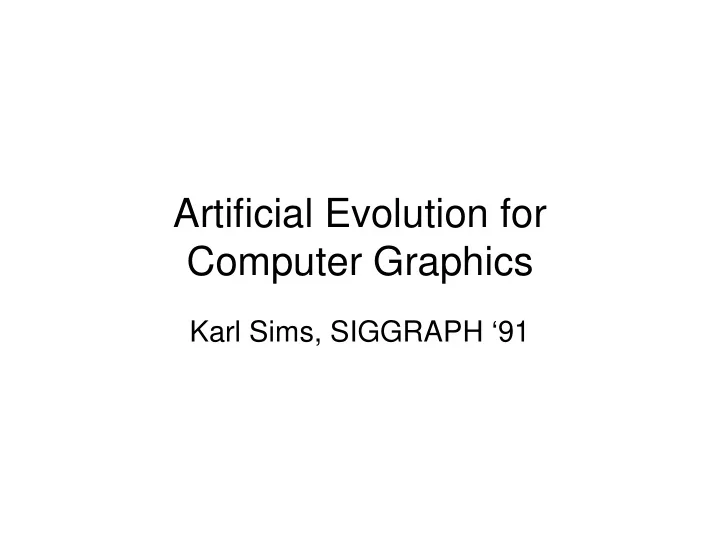

Artificial Evolution for Computer Graphics Karl Sims, SIGGRAPH ‘91
Basic Idea • To apply evolutionary techniques of variation and selection to create complex simulated structures, textures and motions
Why artificial evolution? • More use of Procedural Models in Computer Graphics to create high degrees of complexity • Procedure must be conceived, understood and designed by a human • Artificial evolution permits the creation of a large variety of complex entities which do not require the user to understand the underlying creation process involved
Complex simulated structures, textures and motions • 3D Plant Structures • Volume Textures • Animations
Evolutionary Concepts • Genotype genetic information codes for the creation of an individual • Phenotype the individual itself, the form that results from the developmental rules and the genotype • Selection determined by the fitness of the phenotype, parent selection and survival selection, non- random • Reproduction sexual, asexual, variation/mutation, random
Evolutionary Techniques • Plant generation algorithms -- exploring parameter spaces parameters describing fractal limits, branching factors, scaling, stochastic contributions Mutate and Mate parameter sets • Genetic Algorithms -- Symbolic Lisp expressions as genotype
symbolic expressions as genotype • Genotype -- Lisp expressions which can calculate a color for each pixel(x,y) are evolved using a function set containing proper operations (tree structure) • For example: (round (log (+ y (color-grad (round (+ (abs (round (log (+ y (color-grad (round (+ y (log (invert y) 15.5)) x) 3.1 1.86 #(0.95 0.7 0.59) 1.35)) 0.19) x)) (log (invert y) 15.5)) x) 3.1 1.9 #(0.95 0.7 0.35) 1.35)) 0.19) x)
Genetic Algorithms • 1. Population size: 100 to 1000 or more • 2. Selection: interactive selection • 3. Fitness Evaluation: decided by users • 4. Crossover and Mutation: dependent on probability
A simple flow chart
Results • 3D Plant Structures (Figure 2, Figure 3) • Volume Textures (Figure 5, Figure 6) • Animations (Figure 7)
Future work To automatically evolve a symbolic expression that could generate a specific goal image. Fitness evaluation becomes important.
Recommend
More recommend